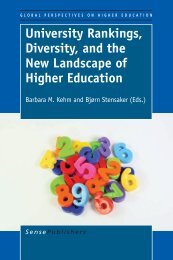Rupturing Concepts of Disability and Inclusion
Rupturing Concepts of Disability and Inclusion
Rupturing Concepts of Disability and Inclusion
You also want an ePaper? Increase the reach of your titles
YUMPU automatically turns print PDFs into web optimized ePapers that Google loves.
CHAPTER 2<br />
Pluhar also outlines the “full-personhood view”, a view that all <strong>and</strong> only “full<br />
persons”, inasmuch as they can be fully aware, autonomous, rational beings, are<br />
“maximally morally significant.” 91 This is classically articulated by Immanuel<br />
Kant, whose concept <strong>of</strong> ‘rational being’ includes the capacity for moral agency:<br />
22<br />
Beings whose existence depends not on our will but on nature have,<br />
nevertheless, if they are not rational beings, only a relative value as means<br />
<strong>and</strong> are therefore called things. On the other h<strong>and</strong>, rational beings are called<br />
persons inasmuch as their nature already marks them out as ends in<br />
themselves, i.e., as something which is not to be used merely as means <strong>and</strong><br />
hence there is imposed thereby a limit on all arbitrary use <strong>of</strong> such beings,<br />
which are thus objects <strong>of</strong> respect. 92<br />
The full-personhood view, though human-centred, is seen to be incompatible with<br />
homocentrism. Humans who fail to be full, autonomous persons are excluded from<br />
full moral consideration <strong>and</strong> significance, unprotected by any theodic considerations,<br />
<strong>and</strong> can be at risk <strong>of</strong> vulnerability <strong>and</strong> disposability. In a full-personhood view,<br />
notions <strong>of</strong> entirety are denied <strong>and</strong> integrality is non-conceived. In such a view,<br />
marginal humans are then afforded similar moral status to animals, <strong>and</strong> this sets up<br />
a “biconditional challenge”. Pluhar describes this as the claim made by such<br />
philosophers as Peter Singer, Bernard Rollin <strong>and</strong> Tom Regan, who advocate that<br />
either marginal humans, like animals, have no moral status, or that higher-level<br />
animals are granted similar or, in some cases, superior moral status than very<br />
marginal humans such as people with intellectual disabilities, the senile, the<br />
comatosed, foetuses, the insane, <strong>and</strong> brain-damaged infants. 93 These ethical debates<br />
<strong>of</strong> personhood <strong>and</strong> human status, 94 which must necessarily inform discussions <strong>of</strong><br />
inclusion <strong>and</strong> exclusion, have been, to a large extent, ignored in literature about<br />
inclusion.<br />
2.4 DIFFERENT ASPECTS OF INCLUSION<br />
A scan <strong>of</strong> the literature suggests that in recent times, two approaches have<br />
dominated practices <strong>and</strong> scholarship about inclusion. First, the technical approach<br />
seeks to translocate within the public arena, historical deficit-focused ideologies <strong>of</strong><br />
disability constructed from notions about individual impaired <strong>and</strong> burdensome<br />
bodies. These translocations, exemplified with the movement from special<br />
institutional to community care or regular settings, are facilitated by technical<br />
processes such as the provision <strong>of</strong> pr<strong>of</strong>essional assessment processes, ‘inclusion’<br />
workers, personal planning <strong>and</strong> skill training programs, <strong>and</strong> attention to the<br />
physical environment. 95 Second, the legislative approach seeks to address the<br />
socio-political context <strong>of</strong> processes <strong>of</strong> disablement by legislation committed to the<br />
protection <strong>of</strong> human <strong>and</strong> civil rights, <strong>and</strong> anti-discrimination processes. 96<br />
This research proposes another approach – an ethical approach – which challenges<br />
exclusion as well as the inadequacy <strong>of</strong> technical <strong>and</strong> legislative processes; <strong>and</strong><br />
identifies hidden assumptions which cause flaws <strong>and</strong> problems for people with<br />
intellectual disability in particular. Descriptive processes <strong>of</strong> exclusion <strong>of</strong> marginal<br />
groups, such as people with intellectual disability, can be found in socio-historical














